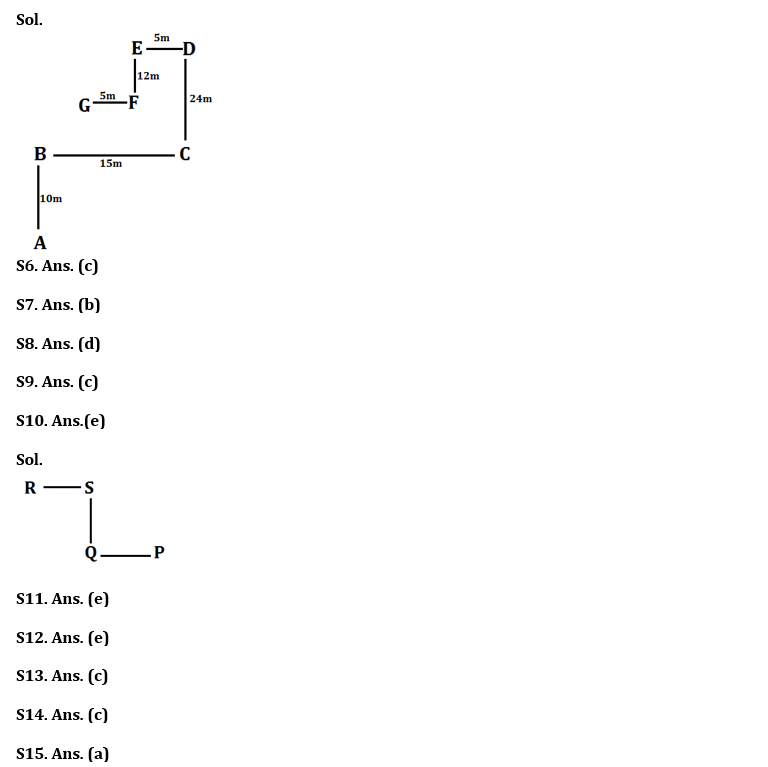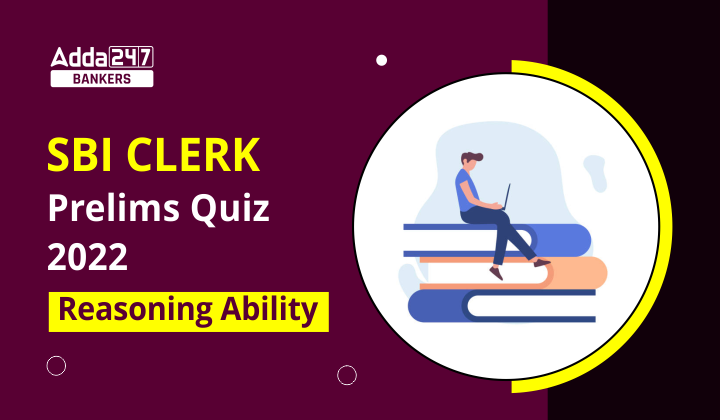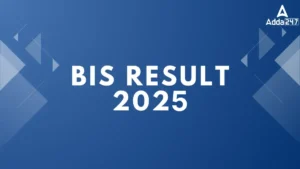Directions (1-5): Study the following arrangement carefully and answer the questions given below:
3 1 2 5 4 7 2 8 4 5 7 1 9 6 5 2 4 1 4 5 8 2 4 3 9 7 6 9 4 2 3
Q1. Which of the following digit will be sixth to the left of tenth from the right end?
(a) 6
(b) 9
(c) 5
(d) 2
(e) None of these
Q2. How many 2’s is there in the given series which are immediately followed by a number less than 6?
(a) One
(b) None
(c) Three
(d) Two
(e) More than three
Q3. What will be the addition of fifth, seventh and tenth digit from the left end?
(a) 13
(b) 10
(c) 11
(d) 15
(e) None of these
Q4. If all the perfect square digits are removed from the given series (excluding 1), then which of the following will be fifth to the right of sixth from the left end?
(a) 5
(b) 2
(c) 8
(d) 1
(e) None of these
Q5. How many odd numbers are there in the given series which are immediately followed by a perfect square digit?
(a) One
(b) None
(c) Three
(d) Five
(e) Seven
Directions (6-9): Study the information carefully and answer the questions given below.
Point B is 10m north of A. Point C is 24m south of D which is 5m east of E. Point G is 5m west of F. Point C is 15m east of B. point F is 12m south of point E.
Q6. What is the shortest distance between G and B?
(a) 14m
(b) 11m
(c) 13m
(d)10m
(e) 5m
Q7. What is the direction of E with respect of G?
(a) South-west
(b) North-east
(c) South
(d) North
(e) North-west
Q8. If point H is 8m north of C, what is the direction and distance of Point H with respect to B?
(a) 12m, North-East
(b) 7m, North
(c) 15m, South-west
(d) 17m, North-East
(e) 10m, North-west
Q9. What is the direction of A with respect to F?
(a) South- East
(b) North- West
(c) South-West
(d) North
(e) South
Q10. If A@B means ‘B is west of A’, A#B means ‘A is south of B’, A%B means ‘A is east of B’ and A&B means ‘A is north of B’. Then what is the direction of P with respect of R in the given expression- P % Q # S @ R
(a) North
(b) South
(c) North- East
(d) South- West
(e) South- East
Directions (11-15): Following questions are based on the five three-digit numbers given below.
947 376 694 739 863
Q11. If all the digits in each of the numbers are arranged in increasing order within the number, then, which of the following number will become the lowest in the new arrangement of numbers?
(a) 947
(b) 863
(c) 739
(d) 694
(e) 376
Q12. If all the numbers are arranged in ascending order from left to right then, which of the following will be the sum of all the three digits of the number which is 2nd from the right in the new arrangement?
(a) 18
(b) 19
(c) 15
(d) 16
(e) None of these
Q13. What will be the difference, when third digit of the 3rd lowest number is multiplied with the second digit of the highest number and third digit of the 2nd highest number is multiplied with the second digit of the lowest number?
(a) 21
(b) 20
(c) 15
(d)16
(e) None of these
Q14. If the positions of the second and the third digits of each of the numbers are interchanged then, how many even numbers will be formed?
(a) None
(b) One
(c) Two
(d) Three
(e) Four
Q15. If one is added to the second digit of each of the numbers and one is subtracted to the third digit of each number then, how many numbers thus formed will be divisible by three in new arrangement?
(a) None
(b) One
(c) Two
(d) Three
(e) Four
Solutions
S1. Ans. (d)
Sol. The 16th element from the right end = ‘2’.
S2. Ans. (e)
Sol. There are four 2’s which are followed by number less than 6 i.e., ‘2 5, 2 4, 2 4 and 2 3’.
S3. Ans. (c)
Sol. The fifth, seventh and tenth digit from the left end are ‘4, 2 and 5′.
Hence, the sum is = (4+2+5) = 11.
S4. Ans. (b)
Sol. After removing all the perfect square digits ‘3 2 5 7 2 8 5 7 6 5 2 5 8 2 3 7 6 2 3’
Then (6+5) = 11th digit from the left is ‘2’.
S5. Ans. (e)
Sol. There are seven odd digits which are followed by a perfect square number- ‘3 1, 5 4, 7 1, 1 9, 1 4, 3 9, 9 4’’






 GA Capsule for SBI Clerk Mains 2025, Dow...
GA Capsule for SBI Clerk Mains 2025, Dow...
 The Hindu Review October 2022: Download ...
The Hindu Review October 2022: Download ...
 BIS Result 2024-25 Out for ASO, JSA and ...
BIS Result 2024-25 Out for ASO, JSA and ...





